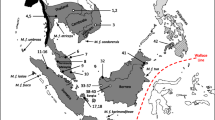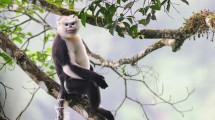Abstract
The Japanese macaques (Macaca fuscata yakui) on Yakushima Island are an endemic subspecies and are closely related to the population of Kyushu, one of the main islands of Japan. Using feces collected throughout Yakushima Island, we examined mitochondrial DNA (mtDNA) to investigate the phylogeography of Japanese macaques. Six haplotypes were observed for a 203-bp fragment of the mtDNA control region. The nucleotide diversity (π) was low (0.0021). The genetic divergence within the Yakushima population was lower (0.009) than that among four haplotypes of the Kyushu population (0.015), calculated using Kimura’s two-parameter method. The mismatch distribution analysis of the six haplotypes of the Yakushima population suggested that the Yakushima population had experienced a sudden expansion in population size, which could be related to the bottleneck effect. The geographic distribution of the mtDNA haplotypes was not uniform. One haplotype was distributed widely, whereas the other five haplotypes were distributed only in the lowlands. The low genetic diversity and biased distribution are discussed in relation to an environmental crash caused by ancient volcanic activity near this island, which is postulated to have happened about 7,300 years ago, and the delayed recovery of highland vegetation.





Similar content being viewed by others
References
Avise JC, Arnold J, Ball RM, Berminghame E, Lamb T, Neigel JE, Reeb CA, Saunders NC (1987) Intraspecific phylogeography—the mitochondrial-DNA bridge between population-genetics and systematics. Annu Rev Ecol Syst 18:489–522
Clement M, Posada D, Crandall KA (2000) TCS: a computer program to estimate gene genealogies. Mol Ecol 9:1657–1660
Eguchi T (1984) Climate of Yaku-shima Island, especially regionality of precipitation distribution. In: Nature Conservation Bureau, Environment Agency, Japan (eds) Conservation reports of the Yaku-shima wilderness area, (in Japanese with English summary). Kyushu, Japan, pp 3–26
Frankham R (1997) Do island populations have less genetic variation than mainland populations? Heredity 78:311–327
Fukuzawa H (1995) Non-glacial varved lake sediment as a natural timekeeper and detector on environmental changes (in Japanese with English abstract). Quat Res 34:135–149
Geographical Survey Institute, Japan (2004) http://www.gsi.go.jp/
Giles RE, Blanc H, Cann HM, Wallace DC (1980) Maternal inheritance of human mitochondrial DNA. Proc Natl Acad Sci USA 77:6715–6719
Goodman SJ, Tamate HB, Wilson R, Nagata J, Tatsuzawa S, Swanson GM, Pemberton JM, Mccullough DR (2001) Bottlenecks, drift and differentiation: the population structure and demographic history of sika deer (Cervus nippon) in the Japanese archipelago. Mol Ecol 10:1357–1370
Hanya G, Yoshihiro S, Zamma K, Matsubara H, Ohtake M, Kubo R, Noma N, Agetsuma N, Takahata Y (2004) Environmental determinants of the altitudinal variations in relative group densities of the Japanese macaques on Yakushima. Ecol Res 19:485–493
Harpending RC (1994) Signature of ancient population growth in a low-resolution mitochondrial DNA mismatch distribution. Hum Biol 66: 591–600
Hayaishi S, Kawamoto Y (2002) Fecal genotyping of mitochondrial DNA polymorphism and fecal age-class estimation of Macaca fuscata yakui: a preliminary report (in Japanese with English abstract). Honyurui Kagaku 42:161–166
Hayasaka K, Ishida T, Horai S (1991) Heteroplasmy and polymorphism in the major non-coding region of mitochondrial DNA in Japanese monkeys: association with tandemly repeated sequences. Mol Biol Evol 8:399–415
Itani J (1972) Social structure of primates (in Japanese). Kyoritsu Shuppan, Tokyo
Iwamoto M, Hasegawa Y (1972) Two macaque fossil teeth from the Japanese Pleistocene. Primates 13:77–81
Japan Meteorological Agency (2004) http://www.jma.go.jp/
Jeanmougin F, Thompson JD, Gouy M, Higgins DG, Gibson TJ (1998) Multiple sequence alignment with Clustal X. Trends Biochem Sci 23:403–405. DOI 10.1016/S0968-0004(98)01285-7
Kan YW, Dozy AM, Trecartin R, Todd D (1977) Identification of a nondeletion defect in α-thalassemia. N Engl J Med 297:1081–1084
Kawamura Y (1994) Late Pleistocene to Holocene mammalian faunal succession in the Japanese islands, with comments on the late Quaternary extinctions. Archaeozoologia 6:7–22
Kawamoto Y (1999) Origin of Japanese macaques in views from genes (in Japanese). Kagaku 69:300–305
Kimura M (1980) A simple method for estimating evolutionary rate of base substitution through comparative studies of nucleotide sequences. J Mol Evol 16:111–120
Kimura M (2000) Paleogeography of the Ryukyu Islands. Tropics 10:5–24
Kumar S, Tamura K, Jakobsen IB, Nei M (2001) MEGA2: molecular evolutionary genetics analysis software. Bioinformatics 17:1244–1245
Kurose N, Kaneko Y, Abramov AV, Siriaroonrat B, Masuda R (2001) Low genetic diversity in Japanese population of the Eurasian badger Meles meles (Mustelidae, Carnivora) revealed by mitochondrial cytochrome b gene sequences. Zool Sci 18:1145–1151
Machida H, Arai F (1978) Akahoya Ash-A Holocene widespread tephra erupted from the Kikai Caldera, south Kyushu, Japan (in Japanese with English abstract). Quat Res 17:143–163
Machida H, Arai F (1992) Atlas of tephra in and around Japan (in Japanese). University of Tokyo Press, Tokyo
Matsuhashi T, Masuda R, Mano T, Yoshida MC (1999) Microevolution of the mitochondrial DNA control region in the Japanese brown bear (Ursus arctos) population. Mol Biol Evol 16:676–684
Mouri T, Agatsuma T, Iwagami M, Kawamoto Y (2000) Species identification by mitochondrial DNA: a case study of macaque remains from Shuri Castle, Okinawa (in Japanese with English abstract). Primate Research 16:87–94
Nei M (1987) Molecular evolutionary genetics. Columbia University Press, New York
Nozawa K, Shotake T, Ohkura Y, Tanabe Y (1977) Genetic variations within and between species of Asian macaques. Jpn J Genet 52:15–30
Nozawa K, Shotake T, Kawamoto Y, Tanabe Y (1982) Population genetics of Japanese monkeys: II. Blood protein polymorphisms and population structure. Primates 23:252–271
Nozawa K, Shotake T, Minezawa M, Kawamoto Y, Hayasaka K, Kawamoto S, Ito S (1991) Population genetics of Japanese monkeys: III Ancestry and differentiation of local populations. Primates 32:411–435
Oi T (1988) Sociological study on the troop fission of wild Japanese monkeys (Macaca fuscata yakui) on Yakushima Island. Primates 29:1–19
Rogers AR, Harpending H (1992) Population growth makes waves in the distribution of pairwise genetic differences. Mol Biol Evol 9:552–569
Rogers AR (1995) Genetic evidence for a Pleistocene population explosion. Evolution 49:608–615
Saitou N, Nei M (1987) The neighbor-joining method: a new method for reconstructing phylogenetic trees. Mol Biol Evol 4:406–425
Schneider S, Roessli D, Excoffier L (2000) Arlequin: a software for population genetics data analysis. Ver 2.000. Genetics and Biometry Lab, Department of Anthropology, University of Geneva
Shigesada N, Kawasaki K, Teramoto E (1986) Traveling periodic waves in heterogeneous environments. Theor Popul Biol 30:143–160
Shotake T, Ohkura Y, Nozawa K (1975) A fixed state of the PGM-2mac allele in the population of the Yaku macaque (Macaca fuscata yakui). In: Contemporary Primatology, 5th International Congress on Primates, Nagoya 1974. Karger, Basel, pp 67–74
Sprague DS, Suzuki S, Takahashi H, Sato S (1998) Male life history in natural populations of Japanese macaques: migration, dominance rank, and troop participation of males in two habitats. Primates 39:351–363
Tomaru N, Mitsutsuji T, Takahashi M, Tsumura Y, Uchida K, Ohba K (1997) Genetic diversity in Fagus crenata (Japanese beech): influence of the distributional shift during the late-Quaternary. Heredity 78:241–251
Tukada M (1982) Cryptomeria japonica: glacial refugia and late-glacial and postglacial migration. Ecology 63:1091–1105
Uehara S (1975) The importance of the temperate forest elements among woody food plants utilized by Japanese monkeys and its possible historical meaning for the establishment of the monkeys’ range—a preliminary report. In: Contemporary Primatology, 5th International Congress on Primates, Nagoya 1974. Karger, Basel, pp 392–400
Ui T (1973) Exceptionally far-reaching, thin pyroclastic flow in southern Kyushu, Japan (in Japanese with English abstract). Bull Volc Soc Jpn, Second Ser 18:153–168
White OL, Densmore III LD (1992) Mitochondrial DNA isolation. In: Hoelzel AR (eds) Molecular genetic analysis of populations, a practical approach, 1st edn. IRL Press, Oxford, pp 29–55
Yamagiwa J, Hill DA (1998) Intraspecific variation in the social organization of Japanese macaques: past and present scope of field studies in natural habitats. Primates 39:257–273
Yoshihiro S, Furuichi T, Manda M, Ohkubo N, Kinoshita M, Agetsuma N, Azuma S, Matsubara H, Sugiura H, Hill D, Kido E, Kubo R, Matsushima K, Nakajima K, Maruhashi T, Oi T, Sprague D, Tanaka T, Tsukahara T, Takahata Y (1998) The distribution of wild Yakushima macaque (Macaca fuscata yakui) troops around the coast of Yakushima Island, Japan. Primate Research 14:179–187
Yoshihiro S, Ohtake M, Matsubara H, Zamma K, Hanya G, Tanimura Y, Kubota H, Kubo R, Arakane T, Hirata T, Furukawa M, Sato A, Takahata Y (1999) Vertical distribution of wild Japanese macaques (Macaca fuscata yakui) in the western area of Yakushima Island, Japan: preliminary report. Primates 40:409–415
Acknowledgements
We thank Drs. T. Nishida, T. Shotake, O. Takenaka, J. Yamagiwa, T. Hikida, S. Suzuki, members of Laboratory of Human Evolution Studies and Dr. D.G. Smith, two anonymous reviewers and Editor-in-chief for fruitful and constructive comments on this paper. And we thank Mr. R. Tsujino for using unpublished data and some participants of Yakushima Macaque Research Group for helping us collecting fecal samples; Drs. Y. Tanaka, A. Yamane, T. Hikida, T. Sota and K. Inaba for helping us in the laboratory; Kamiyaku-cho, Yaku-cho and Yakushima District Forestry Office for permission to this study; Field Research Center of Primate Research Institute, Kyoto University for permission to use the field station in Yakushima and Dr. A. Satoh and many friends in Yakushima Island for their help and hospitality during our fieldwork. This study was financed by Cooperative Research Fund of Primate Research Institute, Kyoto University, and partly by grants-in-aid for Scientific Research, Ministry of Education, Culture, Sports, Science and Technology 09358017 to Dr. T. Shotake, 10CE2005 to Dr. O. Takenaka and 21st Century COE Research Kyoto University (A14).
Author information
Authors and Affiliations
Corresponding author
About this article
Cite this article
Hayaishi, S., Kawamoto, Y. Low genetic diversity and biased distribution of mitochondrial DNA haplotypes in the Japanese macaque (Macaca fuscata yakui) on Yakushima Island. Primates 47, 158–164 (2006). https://doi.org/10.1007/s10329-005-0169-1
Received:
Accepted:
Published:
Issue Date:
DOI: https://doi.org/10.1007/s10329-005-0169-1




